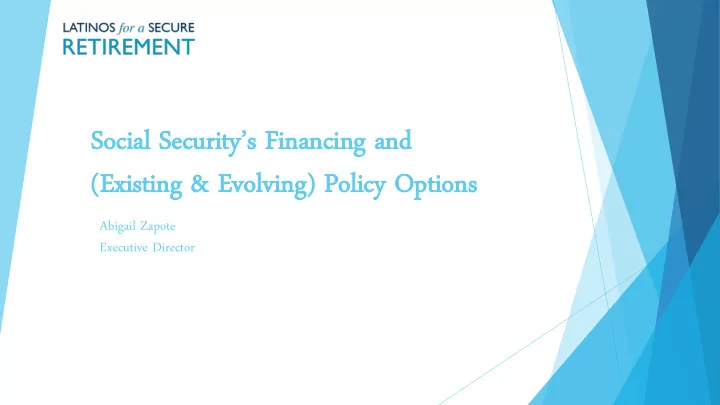

So Social cial Securit Security’ y’s F Financing and inancing and (E (Exist xisting & ing & Evolv lving ing) Po ) Policy licy Op Optio ions ns Abigail Zapote Executive Director
Our mission includes protecting Social Security, strengthening Medicare, increasing pension access and financial literacy, ensuring seniors get equal access to Older American Act services.
Retirement & Two-thirds (66.2%) of working Millennials have nothing saved for Savings Statistics retirement. This situation is far worse for working Millennial Latinos, as 83 for Millennials percent have nothing saved for retirement. Only five percent of working Millennials are saving adequately for retirement. Even though two-thirds (66%) of Millennials work for an employer that offers a retirement plan, only slightly over one-third (34.3%) of Millennials participate in their employer’s plan .
There is a significant gap between Millennial Latinos Retirement & and other racial and ethnic groups in terms of participation in employer-sponsored retirement plans. Savings Statistics Only 19.1 percent of Millennial Latinos and 22.5 percent of Latinas participate in an employer for Millennials sponsored plan, compared to 41.4 percent of Asian men and 40.3 percent of Millennial White women, who had the highest rate of participation in a retirement plan. Four out of ten (40.2%) of Millennials cited eligibility requirements set by employers, such as working a minimum number of hours, or having a minimum tenure on the job, as a reason for not participating in a plan. introduction Hope for improvement for this generation stems from the fact that across all racial and ethnic groups, more than nine out of ten Millennials actually participate in employer-sponsored retirement plans, when they are eligible to participate.
Existing xisting & E Evolving volving Policy Policy O Options tions
Policy Option 1: Consumer Price Index for Elderly (CPI-E) Adoption of a consumer price index (CPI) for the elderly, or CPI-E, as a more accurate means of calculating Social Security Cost Of Living Adjustments. Stop using the CPI-Wage workers. As time goes by, more and more of their Social Security benefit checks will be eaten up by rising health care costs. According to the Medicare Trustees, 33 percent of the average senior’s Social Security check will be consumed by Medicare out-of-pocket costs by 2091, compared with 25 percent today. This proposal would ensure that the Consumer Price Index reflects the expenditures of the elderly and produce a higher cost-of-living-adjustment that truly keeps pace with inflation.
Policy Option 2: Insure College and Vocational Students of Deceased and Disabled Parents Social Security historically paid benefits to children of retired, deceased, or disabled beneficiaries until the age of 22 if they were in college. However, the law was changed in 1981 to end benefits for student children once they either graduated high school or turned 19, in part because of the belief that higher education had become more affordable for disadvantaged youth The cost of providing this important new benefit would be modest, it would only add about 3.5 percent to the projected 75-year deficit. A college graduate will on average make about $26,000 more annually than someone with only a high school education, contributing $145,000 more into the Social Security trust fund over their lifetime.
Policy Option 3: Special Minimum Benefit To protect long service low wage workers, a special minimum benefit should be enacted to pay 125 percent of the poverty line for those who have worked 30 years and retire at the normal retirement age It should be indexed to wage growth in the same way that other benefits are for those newly eligible. A special benefit minimum will ensure benefit adequacy for all Americans. Strengthening the special minimum benefit would increase the projected 75- year deficit by about 6.5 percent.
Policy Option 4: Caregiver Credit Sandwich Generation Problems This proposal would provide caregivers a Social Security earnings credit when they take unpaid time off from their employment to provide care, whether by leaving their jobs or reducing their hours. The credit would be added to earnings to calculate future Social Security benefits for the caregiver’s retirement.
Social ial S Sec ecuri urity’ y’s F Fina nanc ncing ng
Financing Option 1: Gradually Increase the Tax Cap The vast majority of working Americans will contribute to Social Security with every paycheck they earn. This includes even the lowest-paid workers—those who earn the federal minimum wage of just $7.25 per hour—who haven’t seen a raise in 10 years. In 2019, every dollar earned above the payroll tax cap of $132,900 will escape Social Security payroll taxes entirely. It is estimated that if Social Security’s taxable wage base had remained at 90 percent of earnings since 1983, the assets in the combined trust funds would have been $1.4 trillion greater at the end of 2017. This alone would close nearly 11 percent of Social Security’s anticipated 75-year funding shortfall.
Financing Option 2: Creating a Pathway to Legalization for the 11 Million + Undocumented Americans In 2016, Undocumented immigrants contributed $13 Billion into the SS program and $3 billion to Medicare… funds that are not accessible to these communities. DACA and Social Security – An additional 800,000 people into the workforce estimating $31.8 Billion revenue to Social Security If GOP succeeds in plan to cut in half the number of legal immigration, SS will lose $2.4 trillion in revenue over the next 75 years. Alternatively, if immigration doubled, SS would gain $5 Trillion over the next 75 years.
Thank You! Abigail Zapote Abigail@latinosforasecureretirement.org
Recommend
More recommend